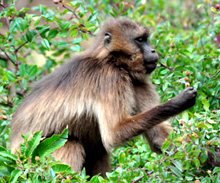Sustainable development of the protected area system of Ethiopia (SDPASE)
Project description
Title: Sustainable development of the protected area system of Ethiopia (SDPASE)
Commissioned by: Ethiopian Wildlife Conservation Authority (EWCA)
Financier: Global Environment Facility (GEF) of the United Nations Development Programme (UNDP); Ethiopian Government – in-kind contributions; national and international institutions as co-financiers
Country: Ethiopia
Lead executing agency: Ethiopian Wildlife Conservation Authority (EWCA)
Overall term: 2008 to 2016

Context
Ethiopia has more than 30 national parks, wildlife reserves, controlled hunting areas and wildlife sanctuaries. Over 6,000 species of plant exist here, many of which have yet to be scientifically documented. The country is a well known destination for bird watchers, as it is home to more than 860 bird species, 16 of which are endemic. There are also 279 species of mammal, of which 35 are endemic. The country is also home to important populations of elephants and lions. Officially, Ethiopia’s protected areas cover 14 per cent of the country.
In the recent past, biodiversity in many of these protected areas has declined as their ecosystems have been exposed to intensive livestock grazing, and settlements have been established in some. The lack of protection has opened the way for environmental degradation, thus threatening the basis of existence for many species of animals and plants. In Ethiopia, however, there is very little awareness of the need for species protection.
Objective
Ethiopia’s biodiversity, ecosystems and ecological processes are safeguarded effectively from adverse human influence through the systematic cooperation of the protected areas and national parks as an association. The natural parks promote tourism in Ethiopia, thus making a significant contribution to economic development at local and national levels.
Approach
The Government of Ethiopia has included environmental issues in the Federal Constitution, and has drafted new policies and passed new legislation. It has also established the Ethiopian Wildlife Conservation Authority (EWCA) as a part of the Ministry of Culture and Tourism. The EWCA has selected GIZ International Services as its implementing partner for each of the programme’s two four-year phases.
To address global challenges such as climate change and the loss of species diversity, the programme is assisting Ethiopia in upholding its constitutional and international commitments to the protection of species. By supporting the recruitment and training of new employees, the programme makes a contribution to poverty reduction and the achievement of the United Nations’ Millennium Development Goals.
The programme is mainstreaming the Protected Area System in the overall development context of Ethiopia, and it is helping to improve conditions for policy, regulation and governance in the sector. It is supporting the various political actors in financial planning, the management of protected areas, and in the development of new management strategies and partnerships for the areas.
Results achieved so far
- The demarcation of the EWCA’s protected areas has been renewed.
- Through the programme, maps have been developed and a GIS system established for the EWCA.
- With advice and support from the programme, a number of wildlife management activities have been implemented, such as aerial population counts.
- By the end of 2013, around 900 protected area employees (scouts) had been trained using teaching materials developed by the programme. These materials include special training manuals that impart basic knowledge in areas such as the management of wildlife populations and protected areas, wildlife tracking and handling weapons. As a result, the protected areas are now being managed more effectively and more sustainably.
- Field equipment has been procured for the employees of the protected areas, especially radio equipment for communication within the park areas. Game wardens’ uniforms have been distributed to both federal and regional authorities. These give the staff added authority, while the new equipment enables them to guard the parks properly against illegal activities.
- Studies have been carried out on important topics, such as the economic value of the Protected Area System, gaps in the cataloguing of the country’s species diversity, the value of the areas involved when viewed as carbon sinks, the marketing of Ethiopia’s wildlife parks, and the legal framework for wildlife management.
- The project has provided advice to the EWCA and the regional wildlife authorities on a variety of issues, such as commercial hunting and management planning.